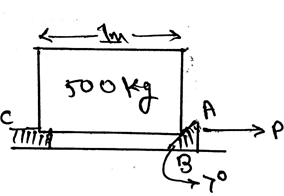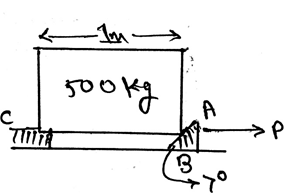This set of Engineering Mechanics Multiple Choice Questions & Answers (MCQs) focuses on “Wedges”.
1. A ____________ is a simple machine that is used as to transfer applied forces into much larger forces.
a) Wedge
b) Beam
c) Pillar
d) Bridges
View Answer
Explanation: The main thing about the wedges is that a wedge is a simple machine that is used as to transfer applied forces into much larger forces. This means that the wedges are the means of force transfer. This machine is very useful in the industries, and it has a wide application.
2. Wedges are used to transfer heavy loads.
a) True
b) False
View Answer
Explanation: The main thing about the wedges is that a wedge is a simple machine that is used as to transfer applied forces into much larger forces. This means that the wedges are the means of force transfer. This machine is very useful in the industries, and it has a wide application.
3. The blocks of heavy weights are being able to lift from the help of the wedges.
a) True
b) False
View Answer
Explanation: The main thing about the wedges is that the wedge is a simple machine that is used as to transfer applied forces into much larger forces. This means that the wedges are the means of force transfer. This machine is very useful in the industries, and it has a wide application.
4. The normal force exerted by the surface of the wedge is normal to the surface of the ________
a) Base of the wedge
b) Base of the body residing over it
c) Base of the body just neighbour to the wedge
d) Earth’s surface
View Answer
Explanation: As we know the normal forces act perpendicular to the surfaces of the body kept over the wedges. Thus the normal force exerted by the surface of the wedge is normal to the surface of the base of the body kept over the wedge. The wedges are very useful in the industries, and it has a wide application.
5. Which one is not the condition for the equilibrium in free body diagram for calculation of the normal forces along the body kept over the wedge, consider all forces to be straight and linear?
a) ∑Fx=0
b) ∑Fy=0
c) ∑Fz=0
d) ∑F≠0
View Answer
Explanation: For the equilibrium in the three dimensional system of axis we have all the conditions true as, ∑Fx=0, ∑Fy=0 and ∑Fz=0. Also, we have the summation of the forces equal to zero. Which is not a non-zero value.
6. The coefficient of friction between the body being slided over the wedge and the wedge surface is generally determined by ____________
a) Written over the Body
b) Experiments
c) Weighing the body
d) Measuring length of the body
View Answer
Explanation: The coefficient of the friction is generally determined by the help of experiments. Many experiments are done on the body. Try and error methods are involved. And the final observations are being taken out. Then average of all the final answers resulted in the experiments is done.
7. When does the two wedge system is termed as self-locking system?
a) If friction forces hold the block in plane
b) If friction forces doesn’t hold the block in plane
c) If friction forces hold the block in phase
d) If friction forces doesn’t hold the block in phase
View Answer
Explanation: If friction forces hold the block in plane the two wedge system is termed as self-locking system. This is generally the concept used to lift up the boxes and then it is also used to make the very heavy works easy. Thus the wedges are very useful in the industries, and it has a wide application.
8. Determine the normal force at B in the wedge shown. Take the value of the coefficient of friction to be 0.3. Assume that the block doesn’t slip at C.
a) 2452 N
b) 215 KN
c) 3150 N
d) 415 KN
View Answer
Explanation: The normal force at A is 2381 N. The normal force at B is 2452.5 N. The angle of the wedge over which the block is being slided is generally taken out by the help of the tangent inverse trigonometric function. Thus the answer.
9. In the free body diagrams involving the wedges we have use of vector math, so for two vectors A and B, what is A.B (if they have angle α between them)?
a) |A||B| cosα
b) |A||B|
c) √(|A||B|) cosα
d) |A||B| sinα
View Answer
Explanation: The dot product of the two vectors is always the product of the magnitudes of the two forces and the cosine of the angle between them. We need to consider the triangle and then accordingly apply the trigonometry. This is one of the ways of resolving the components.
10. What is j.j?
a) 0
b) 1
c) -1
d) ∞
View Answer
Explanation: As the dot product of only the same Cartesian component is unity, i.e. i.i = 1 and j.j =1, rest all remaining dot product will give 0(i.j = 0 and j.k = 0). Cross product of the same plane vectors always give zero. And dot product of the same plane vector gives a scalar quantity.
11. Sometimes in the calculations involving the wedges, there are situations when there is a toppling effect on the body. In that, if the net moment of the body is zero that means the distance between the force and the rotational axis is zero.
a) The first part of the statement is false and other part is true
b) The first part of the statement is false and other part is false too
c) The first part of the statement is true and other part is false
d) The first part of the statement is true and other part is true too
View Answer
Explanation: The net moment of the body is zero that doesn’t means that the distance between the force and the rotational axis is zero. This means moments caused by different forces cancels out. If this happens there is no motion of the body along with any direction and hence the body is said to be in equilibrium.
12. In the simplification of the forces applied in the wedges net force acts at the ___________ of the loading body.
a) Centroid
b) The centre axis
c) The corner
d) The base
View Answer
Explanation: In the simplification of the loading system the net force acts at the centroid of the loading body. That is if the loading system is in the form of the triangle then at the distance 2 by 3 of the base the net force of the loading will act. And the load will be half the area of the loading.
13. Determine the minimum amount of the force P required to remove the wedge shown. Take the value of the coefficient of friction to be 0.3. Assume that the block doesn’t slip at C.

a) 1.15 KN
b) 2.15 KN
c) 3.15 KN
d) 4.15 KN
View Answer
Explanation: The normal force at A is 2381 N. The normal force at B is 2452.5 N. The angle of the wedge over which the block is being slided is generally taken out by the help of the tangent inverse trigonometric function. Thus the answer.
Sanfoundry Global Education & Learning Series – Engineering Mechanics.
To practice all areas of Engineering Mechanics, here is complete set of 1000+ Multiple Choice Questions and Answers.
If you find a mistake in question / option / answer, kindly take a screenshot and email to [email protected]

